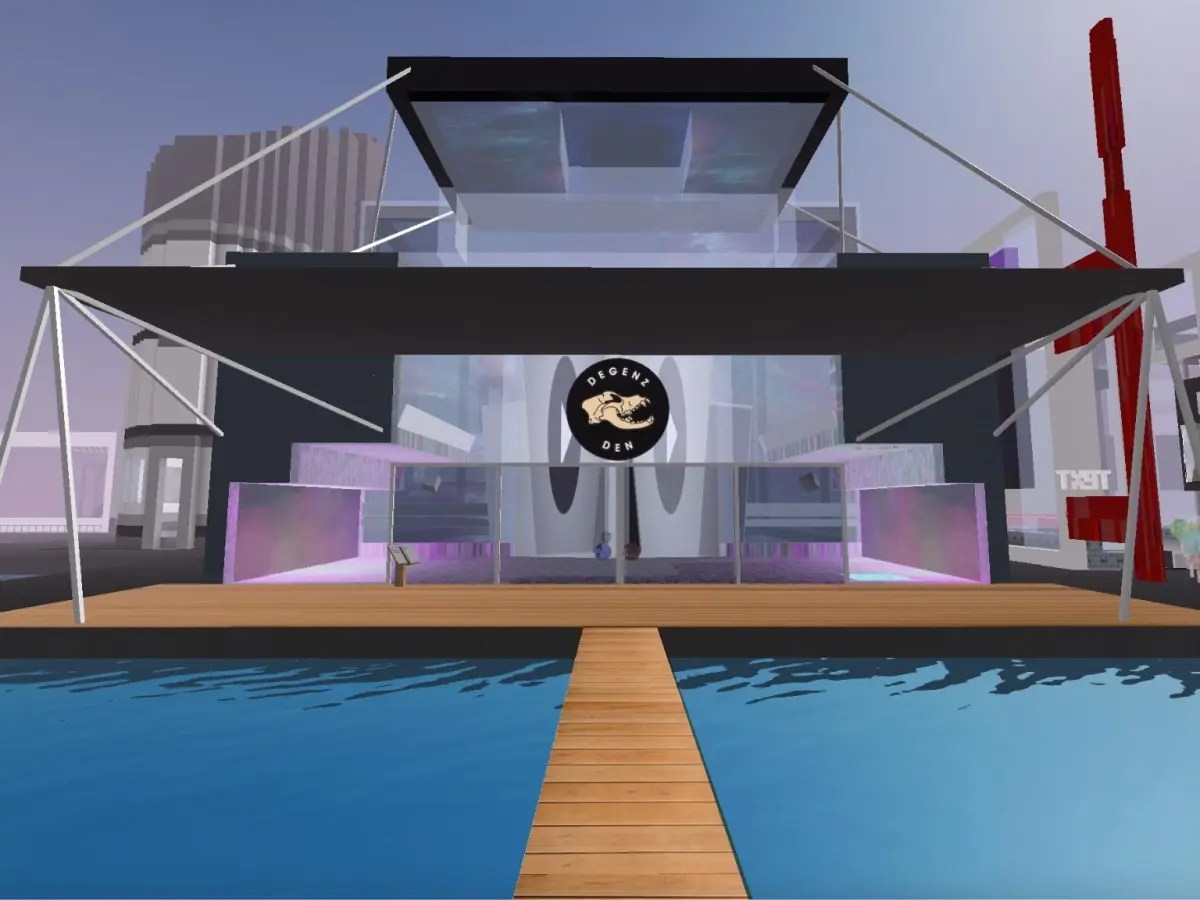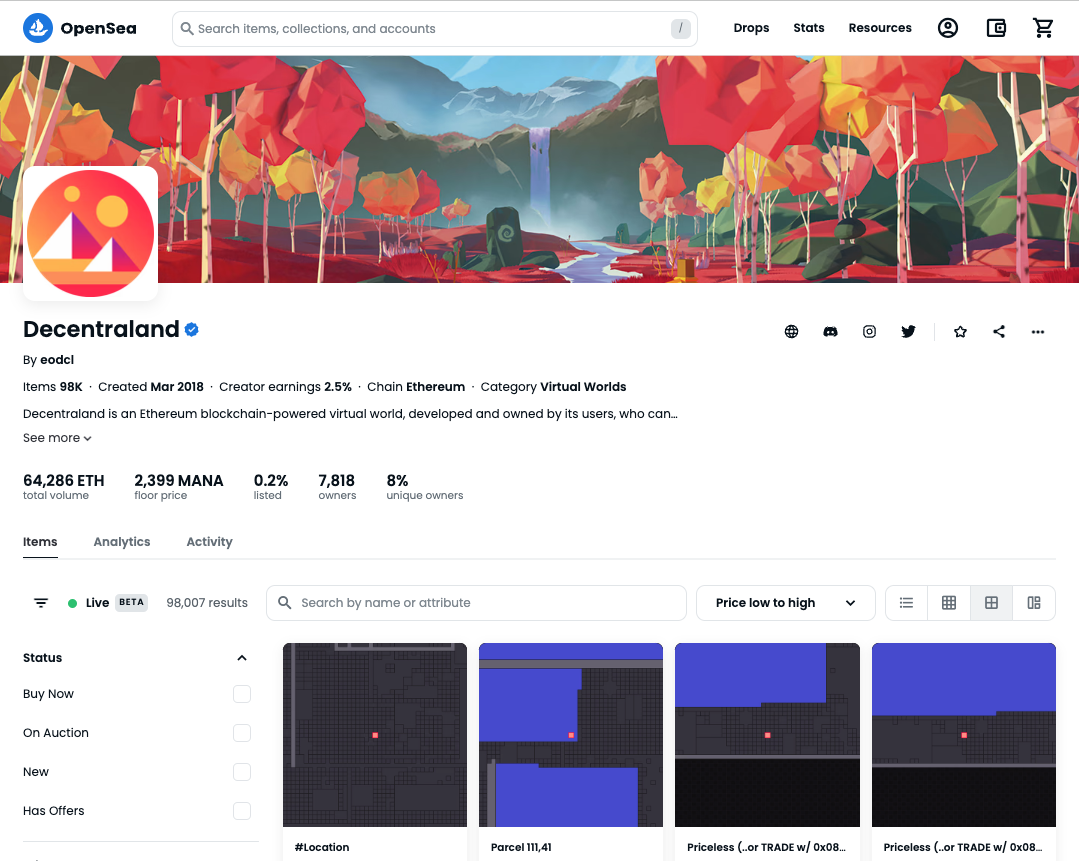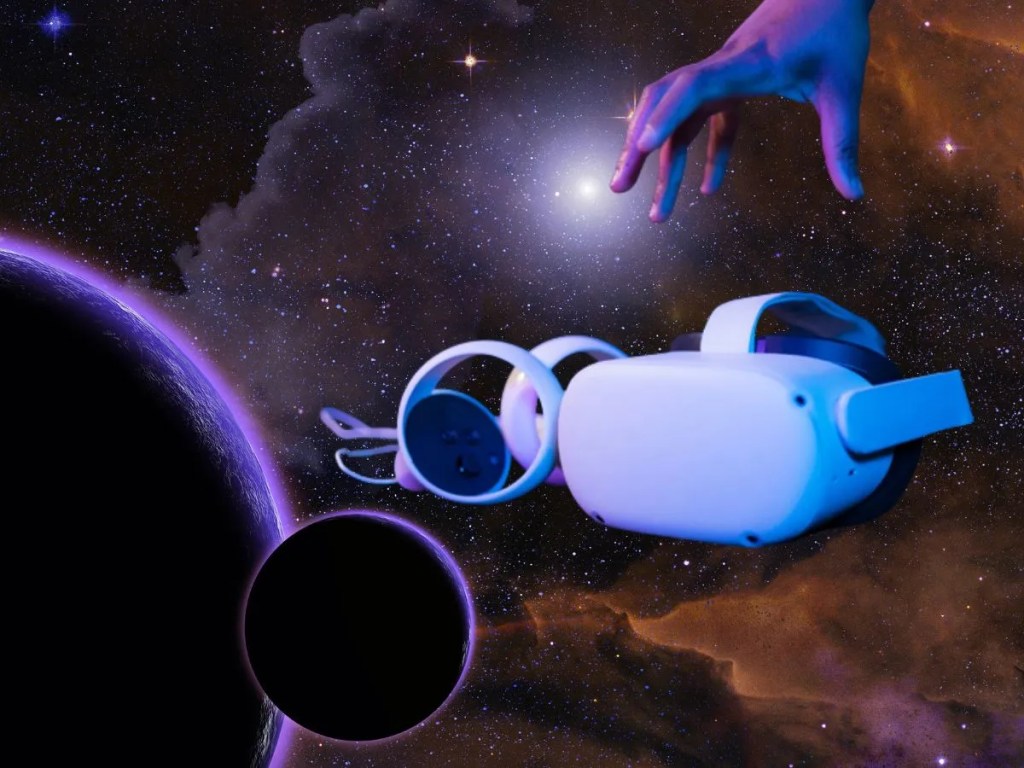What is the Metaverse? The definition of the metaverse differs across the tech landscape — for some, coordinating and interacting on virtual collaborative platforms like Zoom is a part of the metaverse. For the majority, a closer definition of the metaverse is an iteration of the internet that is an immersive network of 3D virtual worlds, facilitated by the use of virtual reality and augmented reality involving systems of commerce and social interaction.
Table of contents
- What does the metaverse mean?
- Metaverse examples
- What are the different types of metaverses?
- What are the major blockchain metaverse platforms?
- What are the biggest non-blockchain based metaverses?
- How to make a metaverse account?
- Where to buy a metaverse coin?
- How to invest in the metaverse?
- How to buy land in the metaverse?
- How many people are in the metaverse?
- Is the metaverse the future?
The most correct definition of a metaverse is one universal world, where different platforms can interact, and users can travel from one to the other. For blockchain proponents, this is a reality that is being built, but we are quite far away from having the right interoperable infrastructure that would allow this vision to be real life.
Speaking to The Chainsaw, John Stefanidis, CEO and founder of NFT gaming platform Balthazar, shared that he believes people have a misconception that the metaverse is “putting on VR headsets and bodysuits”. In his opinion, we’ve been engaging in some of the first iterations of the metaverse by simply engaging with the internet via remote working, shopping and even online dating.
For many, ‘entering the metaverse’ is simply buying a plot of land and building a shop-front as a means for a PR move, or as a way to build a virtual kingdom like Harry and Meghan. It’s a place where fashion shows take place, designers can create digital fashion without the environmental footprint, or phygital fashion that combinates both virtual fashion and IRL garments. It’s also a place to take your next date or wedding.
For this explainer, it’s best to define the metaverse as a virtual world where users can enter and engage in real-world activities from work to shopping to hanging out with friends, all from the comfort of a computer, handheld device or a VR headset (for the brave).
What does the metaverse mean?
Metaverse is a portmanteau of the words ‘meta’ and ‘universe’. Meta in Greek means ‘beyond’ or ‘after’, as the metaverse is a world beyond our current world. It has become a buzzword in recent years to refer to the evolution of the internet known as Web3.
True interoperability of metaverse worlds might be far off, but there have been iterations of virtual world games since the early 2000s in the form of games like The Sims and Second Life, where users controlled avatars in a virtual world.
Some of the most popular worlds that currently exist include World of Warcraft, Minecraft, Fortnite and Roblox. Beyond the gaming space, companies are building spaces for colleagues to congregate in an office, or partake in court proceedings.
According to McKinsey Research, the metaverse could generate up to US$5 trillion in value by 2030. Citi projects this could reach US$13 trillion by that time.
Although many assume that Mark Zuckerburg introduced the metaverse concept to the world during his keynote speech at Connect 2021, the word has been around since the early 1990s, invented by an author named Neal Stephenson where he introduced the concept in his book Snow Crash, a story of Hiro Protagonist, a katana-wielding hacker who jumps back and forth between dystopian Los Angeles and a virtual world which he referred to as the Metaverse.
Metaverse examples
To best understand what a metaverse looks like, Steven Spielberg’s film Ready Player One is a great visual example.
Mark Zuckerberg’s Horizon Worlds platform is also another popular example of a real life metaverse, albeit less ‘futuristic’ compared to Ready Player One.
What are the different types of metaverses?
It’s important to differentiate between blockchain-based and non-blockchain based metaverse platforms. Blockchain metaverse platforms are often built with interoperability in mind — by being built on a compatible blockchain like Ethereum, many blockchain-based platforms envision a future where companies can integrate similarly standardised components that can move virtually across platforms.
By building on blockchains that enable communicative abilities between different metaverses, this would bring us closer to the reality of a true metaverse. Other platforms are usually limited by what’s known as “walled gardens”, meaning they aim to keep players within the game.
What are the major blockchain metaverse platforms?
Decentraland (MANA)
Decentraland is a social virtual universe where you can engage in activities like attending concerts, socialising with mates, or become a virtual real estate investor. Money you make on Decentraland is paid in the form of the platform’s native currency, MANA. Decentraland users access tools that help them build and personalise virtual environments and design interactive experiences. Each year, Decentraland puts on Metaverse Fashion Week.
The Sandbox (SAND)
The Sandbox is a metaverse platform that allows anyone around the world to build, own and market their games using the SAND token on the Ethereum blockchain. Users can create, upload and sell their own games and experiences, and virtual goods.
Voxels
Formerly Cryptovoxels, this metaverse is inspired by Minecraft and consists of customisable land blocks on Ethereum. Voxels uses its own currency CVPA, and properties can be traded on OpenSea. It can be accessed via VR headsets but also via your web browser. You don’t need to have a digital wallet to access its metaverse.
What are the biggest non-blockchain based metaverses?
Horizon Worlds
Owned and published by Meta Platforms, Horizon Worlds is a free virtual reality, online video game platform that can be played with Meta’s Oculus Rift S or Meta Quest 2 VR headset. All players begin in a hub and can take portals to different worlds. Meta has copped a lot of pushback for its environment deemed as “unenjoyable”, with claims of various bugs and user experience issues — and a lack of legs.
Roblox
One of the most popular virtual worlds for kids, Roblox is an app that allows users to play games, create games, and chat with others online. Both kids and adults can download the Roblox application to play its vast catalogue of games. According to Active Player, at the time of writing, Roblox has more than 30 million daily players.
How to make a metaverse account?
While there are slightly different steps across the various metaverse platforms, they are fairly similar.
This guide will explore two of the major metaverse applications, Decentraland and The Sandbox.
1) Create a crypto wallet with a trusted digital wallet exchange
Crypto Wallets such as Metamask and Coinbase are compatible with both Decentraland and The Sandbox, so you can make trades, purchase on the marketplace as well as buy and sell land with cryptocurrency.
2) Head on over to the metaverse application website
Once you have your wallet set up, you’ll need to go to the Decentraland or The Sandbox website and start exploring. It’s important to ensure you are on the authentic metaverse official website as you’ll be using your crypto wallet to sign in, and there are plenty of fraud websites out there that will be happy to take your crypto wallet login details (and steal all your cryptocurrencies).
3) Create an account on the metaverse
Once you land on the authentic metaverse platform website, you’ll be redirected to a login page, where you will be able to create an account, sign in, or play as a guest (if you want to try before you buy). If you are creating an account, you’ll be asked to connect with a Web3 supported wallet provider such as Metamask, Coinbase, Fortmatic and WalletConnect. Once you connect your wallet, you’ll be asked for a digital signature to confirm connecting your wallet to the platform.
4) Create your avatar
Now the fun part. Once you’ve linked your wallet and set up your account, you’ll be able to design how you want to look in the metaverse. Everything from the size of your avatar’s head to its toes you’ll be able to customise as well as the type of clothing and style you’re pursuing in the virtual world too.
Where to buy a metaverse coin?
There are various metaverse tokens, some of the leading ones are SAND (The Sandbox), MANA (Decentraland) and ENJ (Enjin Coin).
These tokens are essentially a unit of virtual currency acting as the basis for transactions and interactions on the metaverse. These coins can be used on the relevant metaverse platforms to engage in activities such as buying and selling land, assets, and shopping on the marketplace. You can almost think of the different metaverse coins as currencies for different countries such as AUD and USD.
You can purchase metaverse coins on all the major crypto exchanges such as Coinbase, Binance, Kraken and Crypto.com.

How to invest in the metaverse?
There are many different ways to invest in the Metaverse, depending on your risk tolerance and financial position. You should definitely do your own research before making any decisions.
1) Purchase metaverse tokens on cryptocurrency exchanges
Most of the major metaverse tokens can be purchased on trusted crypto exchanges such as Coinbase, crypto.com, Binance & Kraken.
2) Purchase traditional shares on the stock exchange exposed to the metaverse
You can purchase traditional stocks in companies that are developing and building the metaverse such as Meta Platforms or Microsoft. If you’d rather take a more diversified approach to your investing and be exposed to a range of metaverse companies, the Betashares Metaverse ETF (ASX: MTAV) tracks the Bloomberg Metaverse Select Index, which currently contains stocks of various companies involved with the metaverse around the world — such as NVIDIA Corporation (NASDAQ:NVDA), Roblox Corp (NYSE: RBLX), and even Apple Inc (NASDAQ: AAPL). Indices like the Hang Seng metaverse index tracks the performance of Chinese and Hong Kong companies involved in the metaverse.
3) Buy LAND in the metaverse
Another way to invest in the metaverse is through investing in land on one of the various worlds, which can be found on platforms like OpenSea. It’s worth noting that metaverse land can be incredibly volatile — at its peak, the average price of land in Decentraland reached US$37,000 in February 2022, but dropped to an average of $5,000 by August.

How to buy land in the metaverse?
1) Buy SAND or MANA
Depending on which platform you’ll be purchasing land on, you can top up your wallet with the above crypto providers mentioned above.
2) Buy ETH
You’ll need some ETH (Ethereum) in your wallet to pay for gas fees (transaction fees) when you purchase land, so make sure your wallet is topped up with ETH.
3) Transfer SAND or MANA into your Metaverse account
Click on the ‘Me’ section on the left sidebar and select your wallet under the ‘My Wallet’ section. Copy and Paste this address and input this into your external wallet or exchange to transfer funds into your metaverse account.
4) Buy LAND on the map
If you are on The Sandbox head over to the map and choose from the grey or yellow (premium) LANDS available. When you select a LAND on the map to purchase, you’ll be able to see its location, size, blocks included and price. You’ll have to confirm and agree to the terms and conditions before the transaction is completed. Similarly on Decentraland, go to the LAND tab where you’ll find all the land parcels available for purchase.
How many people are in the metaverse?
As the metaverse is still a fairly new territory, it is unclear how many people currently ‘inhabit’ the metaverse. Sure, every now and then, famous celebs like Saweetie and Snoop Dogg hold concerts in the metaverse, but that hasn’t successfully attracted in a permanent stream of metaverse ‘citizens’.
Is the metaverse the future?
As discussed, we are still far away from building a consistent standard for metaverse platform development, and there is currently a lack of clear governance standards. Some proponents have raised concerns about the collection of personal information through interactions and biometric data from wearable VR and AR devices. Others have expressed concerns that it could cause user addiction in young people, and there have been cases of virtual assault in metaverse worlds.
But according to KPMG, within five years, hundreds of millions of virtual reality tools and platforms are expected to be embraced by consumers and businesses globally, and these technologies will become a normal part of our everyday lives by the end of the decade.





